MARIANI’S
Virtual Gourmet
October 15,
2017
NEWSLETTER
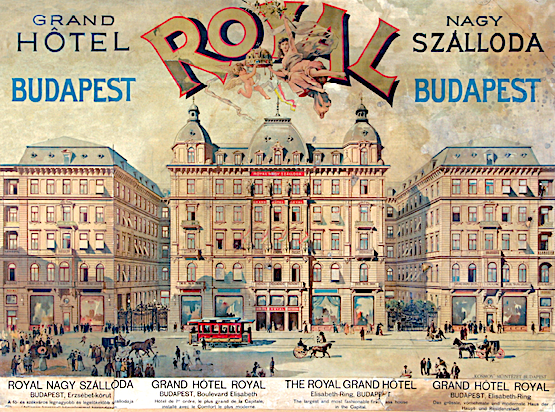
IN THIS ISSUE
BARBADOS SAFE FROM HURRICANES
By John Mariani
NEW YORK CORNER
FLAMES STEAKHOUSE
By John Mariani
NOTES FROM THE WINE CELLAR
A SWEET REVIVAL OF CHAMPAGNES
By Geoff Kalish
❖❖❖
BARBADOS SAFE FROM HURRICANES
By John Mariani
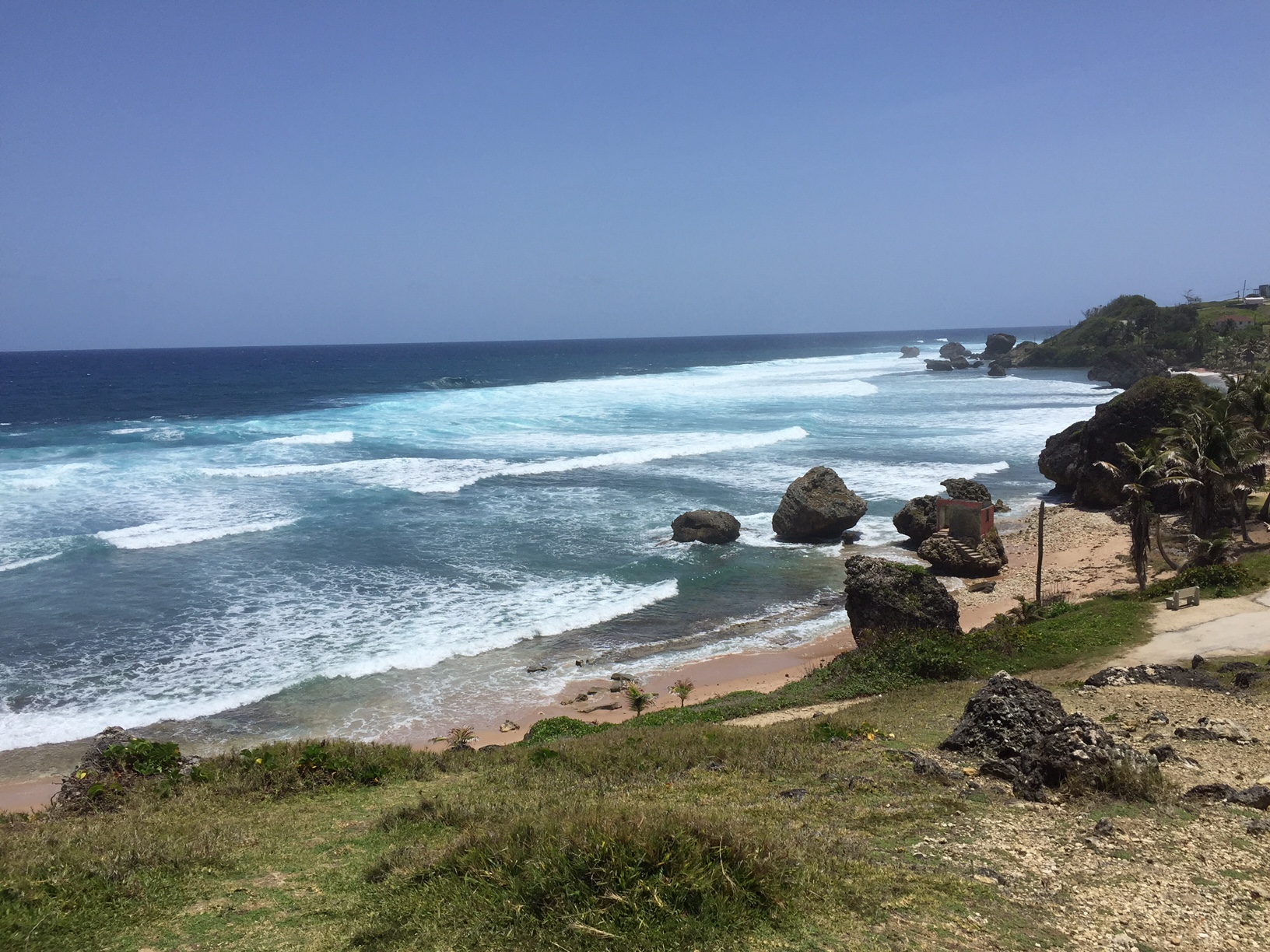
As has been
historically the case, Barbados is one Caribbean
island that suffered few ill effects from
hurricanes--this year Irma and Maria--owing to
its location in the Lesser Antilles east of the
hurricane zone.
Thus, this story, based on a visit
earlier this year, still holds true, making the
island one of the few wholly open to visitors
this season.
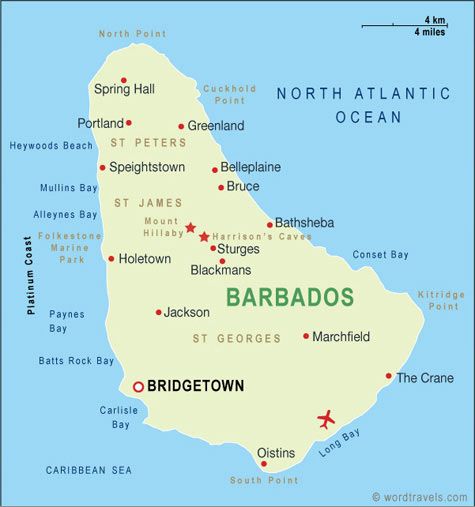 No one knows quite why
Barbados is named after “the bearded ones,” or
even which European visitors first set foot on the
island. Nor
has anyone traced the origin of the colloquial
term “Bim” used by the locals for their island. The
Spanish and Portuguese nosed around the island,
but after the British claimed it in 1625 as a
colony, dubbing
it the “brightest jewel in the English crown,” the
island was never afterwards invaded, and owing to
its position in the Antilles, hurricanes rarely
hit the island.
No one knows quite why
Barbados is named after “the bearded ones,” or
even which European visitors first set foot on the
island. Nor
has anyone traced the origin of the colloquial
term “Bim” used by the locals for their island. The
Spanish and Portuguese nosed around the island,
but after the British claimed it in 1625 as a
colony, dubbing
it the “brightest jewel in the English crown,” the
island was never afterwards invaded, and owing to
its position in the Antilles, hurricanes rarely
hit the island. 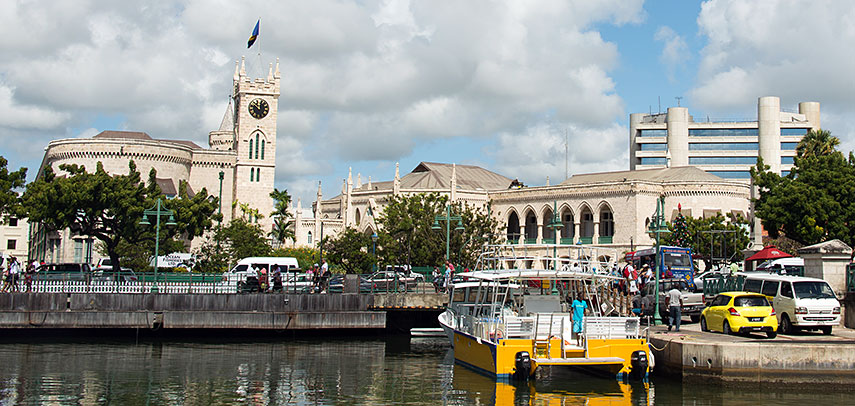
Barbados is fairly large, with eleven parishes spread over 167 square miles, and there is scarcely a hilltop that does not offer a stunning view of the Caribbean. A day’s visit to the evocative capital city, Bridgetown (below), proves why it has been declared a UNESCO World Heritage site. The western side of the island is now slowly getting built up after downturns in the economy after 9/11 and the crash of 2008. But today that side has earned the name “Platinum Coast” for the number of affluent homes and resorts that line sandy beaches. Poverty still remains and unemployment is high, so consistent tourism is an essential industry for Barbados.
There is a lovely Caribbean lilt in the “Bajan” (Bay-jun) Creole-English as spoken by the Barbadians—if you listen carefully you might hear it in the voice of the island’s most famous citizen, Rihanna, who was born in Saint Michael and raised in Bridgetown—and reggae music pours out of restaurants, seaside thatched-roofed bars, and shops along Bridgetown’s streets. The houses and downtown buildings are painted every color of the rainbow that soaks in the sun to achieve a washed-out, toned down pastel patina.
For lack of space I shall pass over the more obvious attractions available in various forms elsewhere in the Caribbean—snorkeling and scuba diving, catamarans and charter fishing, the Carlisle Bay Marine Reserve and Barbados Wildlife Preserve, horseracing and, in good British tradition, cricket matches. Let me concentrate, instead, on Bridgetown itself, where I was fortunate to have an extraordinary guide named Morris Greenidge, historian and author of Bridgetown Barbados: A Walking Tour (2015), who was that rare amalgam of depthless knowledge and local lore combined with a palpable passion for his hometown.
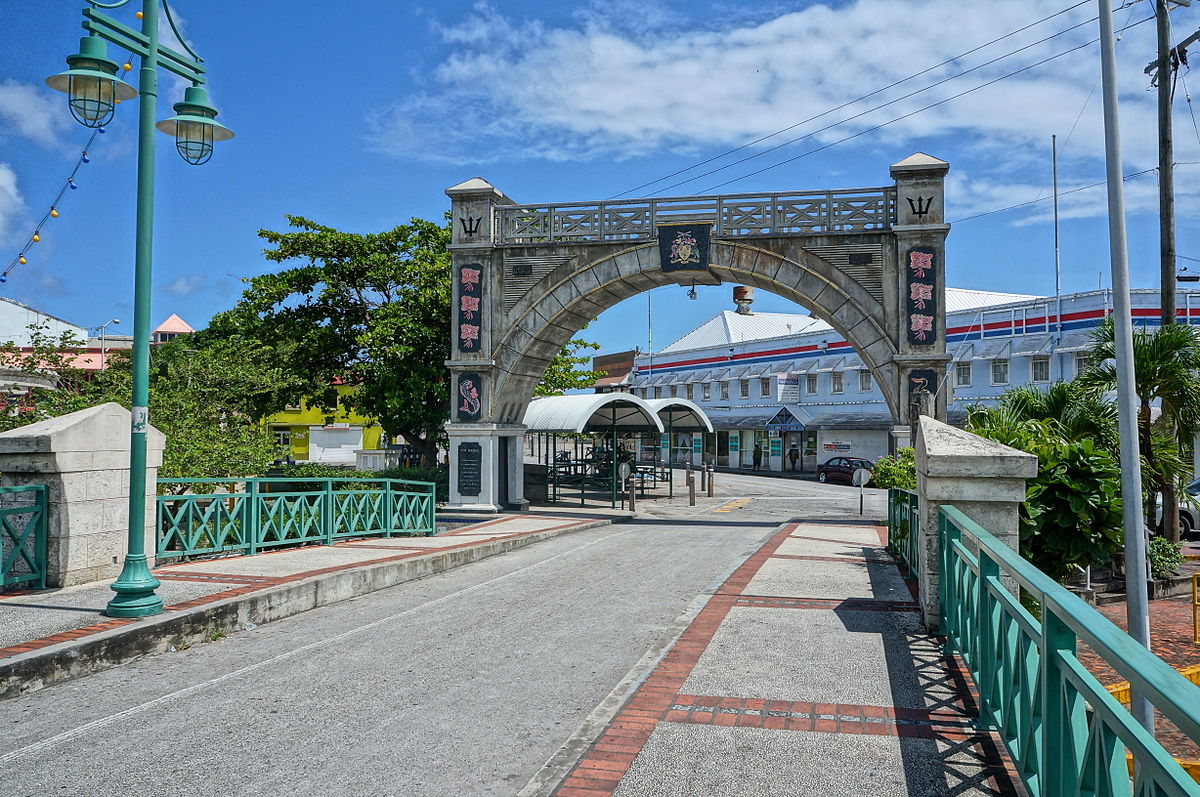 I met
Greenidge at the harbor in town, a large,
gray-haired man wearing suspenders and a
straw-hat. From the moment I asked him a question
I knew there was none he could not answer, always
at great length.
He is as much an authority on the still
controversial history of slavery in the
Caribbean—after several revolts the trade was
banished in 1834—as he is on how the original
tobacco, cotton and indigo industries were
replaced by the importation from Brazil of sugar
cane, for which slave plantations were requisite.
I met
Greenidge at the harbor in town, a large,
gray-haired man wearing suspenders and a
straw-hat. From the moment I asked him a question
I knew there was none he could not answer, always
at great length.
He is as much an authority on the still
controversial history of slavery in the
Caribbean—after several revolts the trade was
banished in 1834—as he is on how the original
tobacco, cotton and indigo industries were
replaced by the importation from Brazil of sugar
cane, for which slave plantations were requisite.
Greenidge has a story about every steeple, every
house, every block of Bridgetown. There’s a spot
on the corner of Palmetto where rum was developed;
the site of the first and only synagogue (1654). Over
there is Cheapside, once the end of the Indian
trail and where what used to be the “Kissing
Bridge” arched the canal; there’s the site of the
old hotel once run by a “most beautiful mulatto
woman” named Caroline Lee, after whom they named a
yellow sweet potato; Parliament Square with its
statue of Lord Nelson and its House of Assembly
with stained glass portraits of every British
monarch from James I to Victoria; every block
tells an old story and Greenidge knows them all,
delivered in the calm, cadenced way of a man who
still reveres so much of what has disappeared
during and long before his lifetime.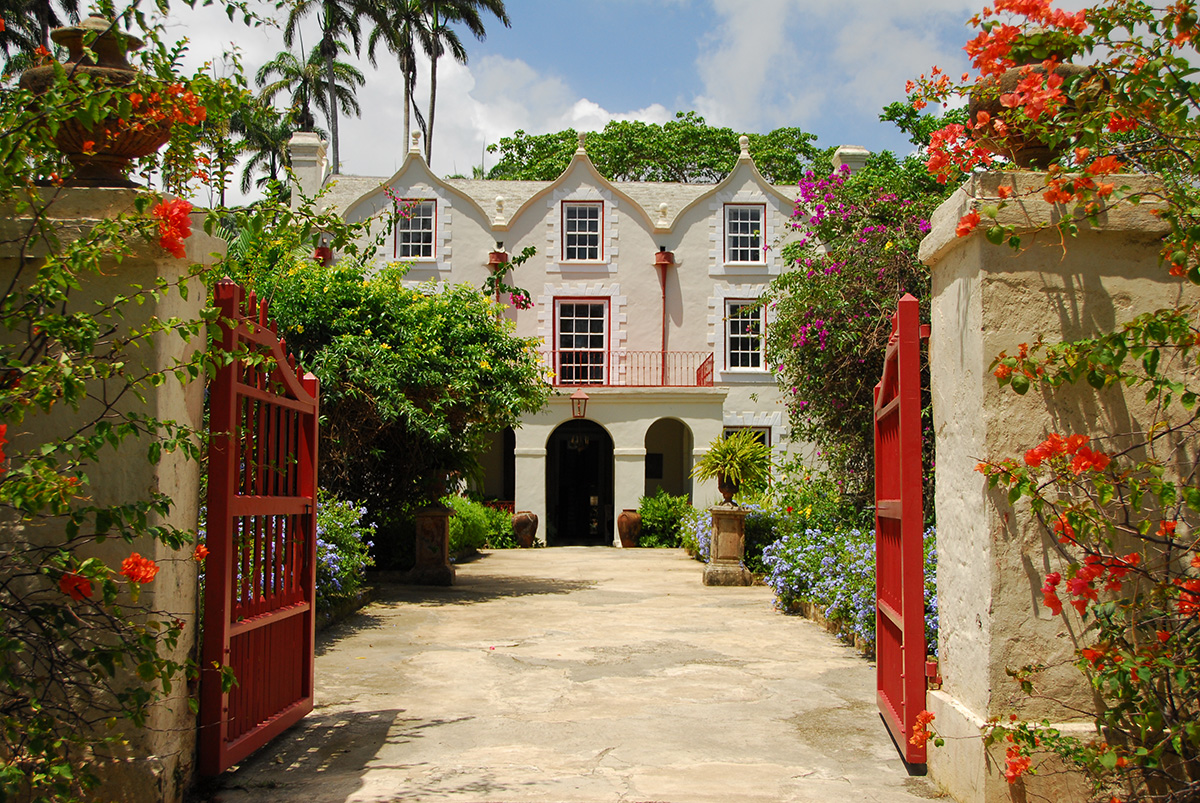
On my own I visited the beautiful St. Nicholas Abbey (right), one of only three remaining Jacobean houses in the entire Western Hemisphere, built in 1660 and now admirably maintained as a family home by architect Larry Warren, his wife, Anna, and their sons, Simon and Shae, who purchased the property in 2006 and impeccably restored its interiors and gardens. The rooms are filled with impressive 18th century antiques, dining tables set with old china, Tudor arches, Chippendale staircases, and two bedroom floors. There is also an outdoor café for a light lunch.
On premises is also a working distillery (one of four on the island), whose award-winning rums include a five-, twelve- and eighteen-year-old you can purchase at the estate after watching the actual process of turning sugar cane into “Kill devil” rum in a copper still named Annabelle.
(A visit to St. Nicholas Abbey makes one to the Mount Gay Distillery wholly unnecessary, for the latter’s tour is more of a commercial venture designed to “herd-‘em-in, give-‘em-a-tot, sell ‘em a t-shirt and bottle of rum” without actually showing the rum production.)
 Animal Flower Cave (left)
in St. Lucy parish on the northern tip of Barbados
is well worth a trip. You descend steep wooden
stairs to a cave whose sea anemones give it its
name, whereupon you gaze out a jagged rip of rock
to the sea as the waves dash themselves against
the opening. Be sure to wear shoes that can grip
the very slippery rocks; I thought I did but still
dashed myself against the rocks, and, though
unharmed, I wondered how long it would take a
rescue party to get me out of there had I broken a
few bones.
Animal Flower Cave (left)
in St. Lucy parish on the northern tip of Barbados
is well worth a trip. You descend steep wooden
stairs to a cave whose sea anemones give it its
name, whereupon you gaze out a jagged rip of rock
to the sea as the waves dash themselves against
the opening. Be sure to wear shoes that can grip
the very slippery rocks; I thought I did but still
dashed myself against the rocks, and, though
unharmed, I wondered how long it would take a
rescue party to get me out of there had I broken a
few bones.
Far grander and different
than the Animal Flower Cave is Harrison’s Cave (right),
known since 1785 but for centuries impenetrable.
It was opened by the Barbados government in 1981
to the public, and there are now  tours throughout the day
in guided tram cars that wind through 1.5 miles of
still active caverns, meaning that water is still
creating, drop by drop, the stalactites and
stalagmites of wondrous beauty, one outcropping
unlike any other.
You rise, then descend deeper and deeper
before emerging into the light again. There are
some tours that delve farther into more cramped
spaces, and, if you’re so inclined, you can even
get married in them.
tours throughout the day
in guided tram cars that wind through 1.5 miles of
still active caverns, meaning that water is still
creating, drop by drop, the stalactites and
stalagmites of wondrous beauty, one outcropping
unlike any other.
You rise, then descend deeper and deeper
before emerging into the light again. There are
some tours that delve farther into more cramped
spaces, and, if you’re so inclined, you can even
get married in them.
If you Go
Barbados’s
currency is tied to the U.S. dollar at a rate of
one US$ to two Barbados dollars. There is a VAT
tax of 17.5% at hotels and restaurants, and a
10% service charge is added to your hotel bill;
tipping at a restaurant is 10-15%.
❖❖❖
By John Mariani
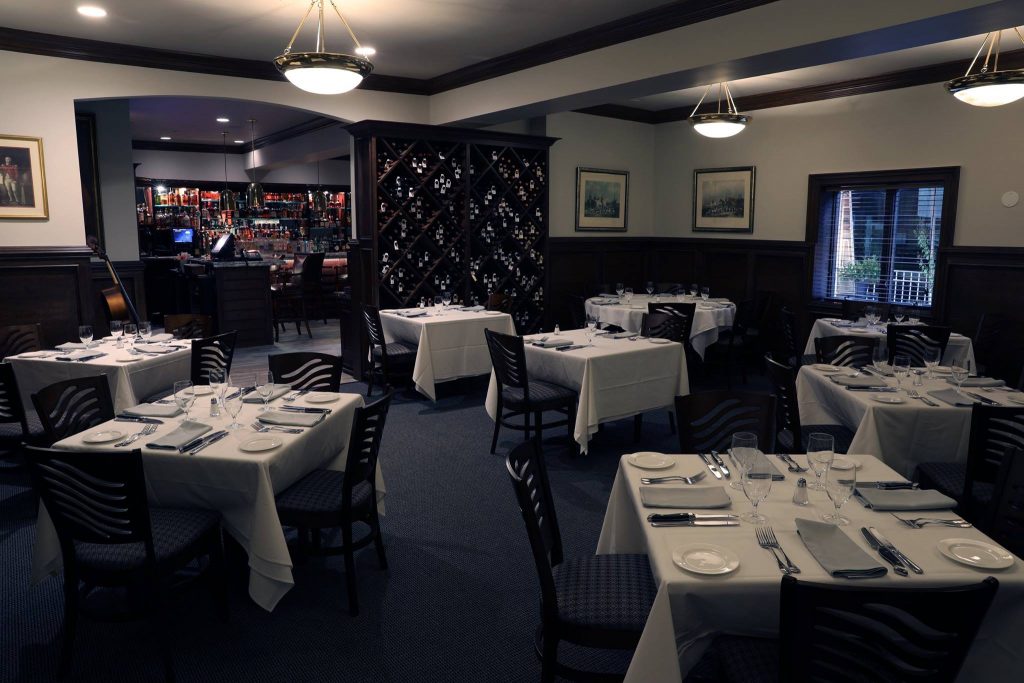 FLAMES
STEAKHOUSE
FLAMES
STEAKHOUSE121 EAST MAIN STREET
ELMSFORD, NY
914-592-3500
It is
a general rule among all restaurants that a menu
has both high quality and lesser quality dishes,
which is especially the case with American
steakhouses, where the menus do not radically
differ one from another.
Thus, after
saying the beef is of excellent quality, one might
find that the hash browns are not up to snuff or
the desserts are mere afterthoughts and the wine
list all too familiar. Rare is the steakhouse
where every item on the menu is at the same
standard of quality.
The new Flames Steakhouse in
Elmsford, a suburb of NYC in Westchester County,
achieves that standard and does so at prices a bit
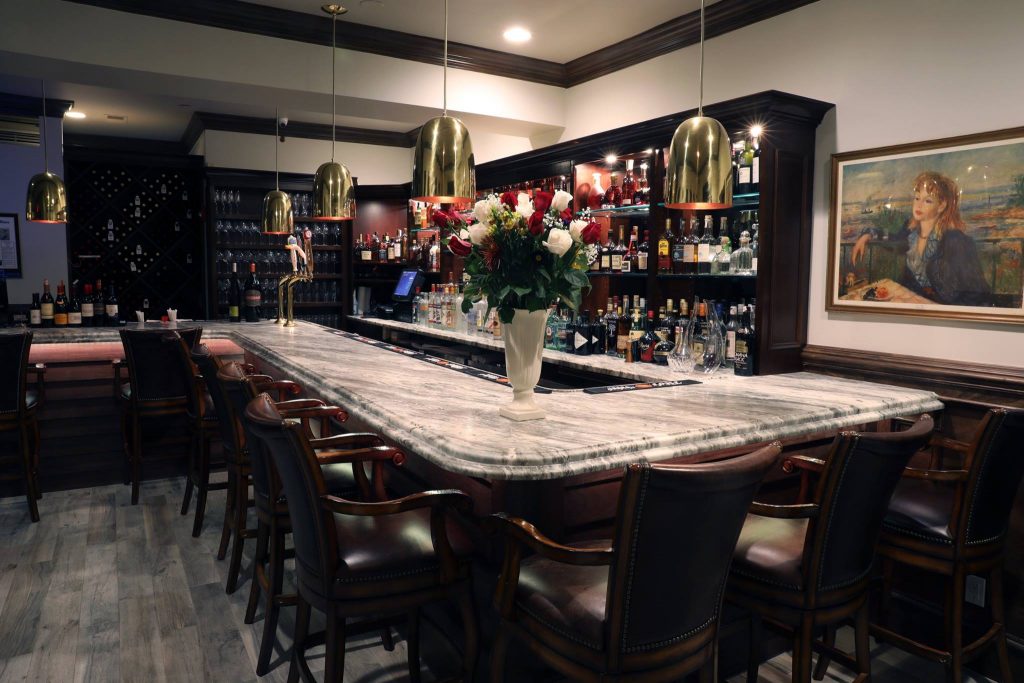 lower than what you’d expect in
Manhattan. Owner and executive chef Nikolla Vulaj,
originally from Montenegro, has had decades to
attain then maintain a place in the first rank of
TriState area steakhouses, having opened his first
in 1992 in Briarcliff, N.Y., also in Westchester
County (now owned by others under the name Flames
Bar and Grill). Now just two months old, the new
lower than what you’d expect in
Manhattan. Owner and executive chef Nikolla Vulaj,
originally from Montenegro, has had decades to
attain then maintain a place in the first rank of
TriState area steakhouses, having opened his first
in 1992 in Briarcliff, N.Y., also in Westchester
County (now owned by others under the name Flames
Bar and Grill). Now just two months old, the new
Flames is already a
restaurant worth seeking out whether or not you
live in the ‘burbs. It’s a handsome three-room
affair: A spacious lounge with a curving marble
bar and dark woods is well stocked, and the
bartender pays attention to how you order your
cocktail; the main dining room, with an impressive
marble fireplace, soft overhead lighting, dark
wainscoting, very comfortable chairs, tilted
mirrors and white tablecloths has a civilized but
unpretentious cast, well served by a staff of
veterans who work in teams. There are walls
stocked with wine, about 250 selections and
growing, and Vulaj knows every one of them well.
To the right is another, brighter room.
There are fine
little touches like the presentation of a good
loaf of bread and a big slab of butter, along with
hot potato chips cooked in beef fat
that adds decided flavor.
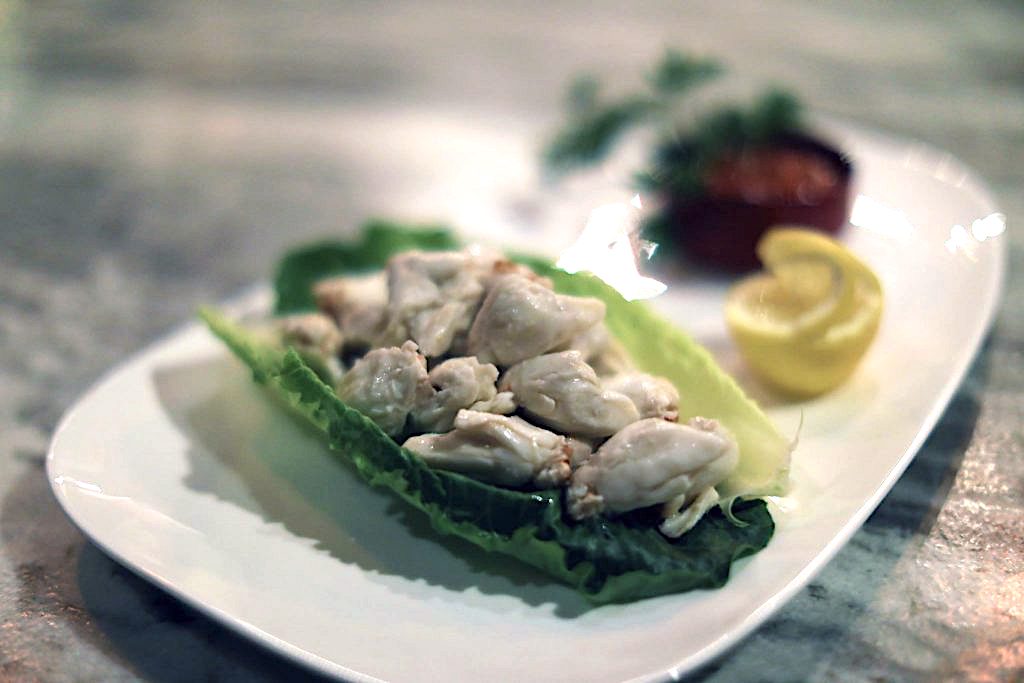 I’ll
get
to the quality of the meat in a moment, but one
item in particular among the appetizers typifies
Vulaj’s commitment to buying the best. At better
steakhouses a crabmeat cocktail ($21.95) might—if
you’re lucky—be made with jumbo size lump crab,
but it is extremely rare when, as at Flames, you
get a generous portion of colossal crabmeat (left), which
wholesale runs $36 per pound.
I’ll
get
to the quality of the meat in a moment, but one
item in particular among the appetizers typifies
Vulaj’s commitment to buying the best. At better
steakhouses a crabmeat cocktail ($21.95) might—if
you’re lucky—be made with jumbo size lump crab,
but it is extremely rare when, as at Flames, you
get a generous portion of colossal crabmeat (left), which
wholesale runs $36 per pound.
The same goes
for the extra large shrimp ($19.50), twin lobster
tails ($54), and the ingredients in the salads.
The eggplant
rollatini ($12.95) with prosciutto and
melted fontina in a light tomato-tinged cream
sauce is very good, and I cannot think of a
more classic rendering of spaghetti alla carbonara—no
cream, no onions, no parsley—than I’ve had at
Flames, and the portion will easily feed two
($26.95).
The veal chop
with mushrooms ($48.95) weighs in at about 16
ounces,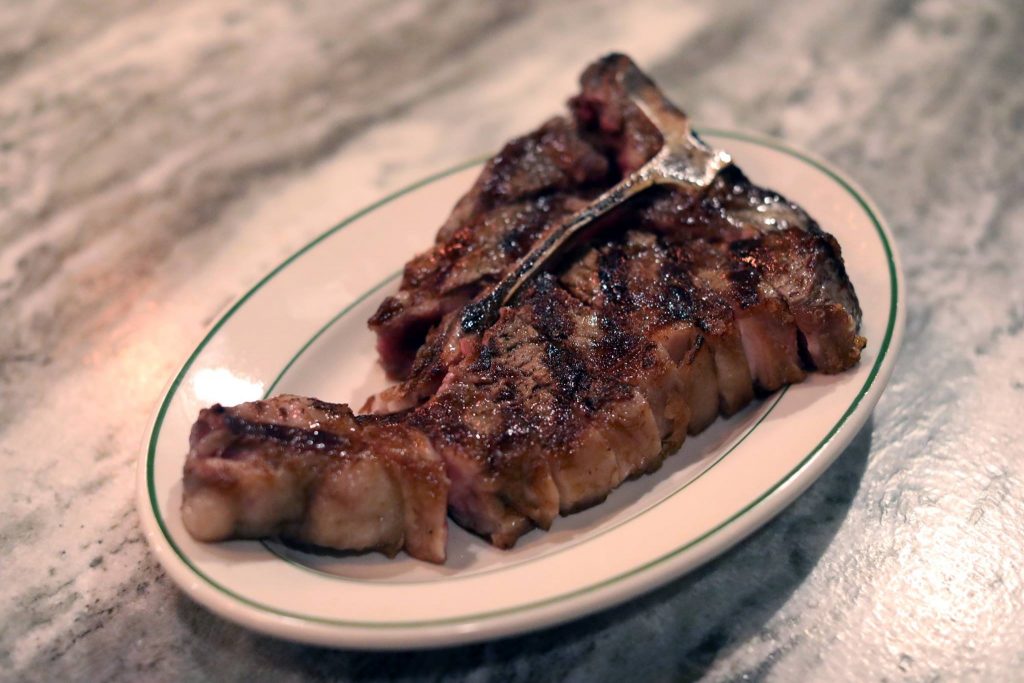 and the
American rack of lamb is comprised of four
beautifully trimmed chops. Lobsters of various
sizes—three to four pounds (MP)—are either
expertly broiled or steamed, served with a ramekin
of clarified butter.
and the
American rack of lamb is comprised of four
beautifully trimmed chops. Lobsters of various
sizes—three to four pounds (MP)—are either
expertly broiled or steamed, served with a ramekin
of clarified butter.
Flames carries the usual cuts
of beef, from filet mignon ($48.95) to
porterhouses cut for two to four people ($98 to
$188), and over many years of eating beef at
Vulaj’s restaurants, I know that he searches out
the best USDA Prime he can get his hands on, and
his kitchen knows how to give them a good char
while keeping the juices inside. He also serves
Japanese wagyu beef (MP) when available, and if
that’s your idea of gluttony, you might as well go
with it here.
Side dishes
get just as much care, from creamed spinach ($8)
that seems equal parts cream, butter and spinach,
lightly seasoned, to various
kinds 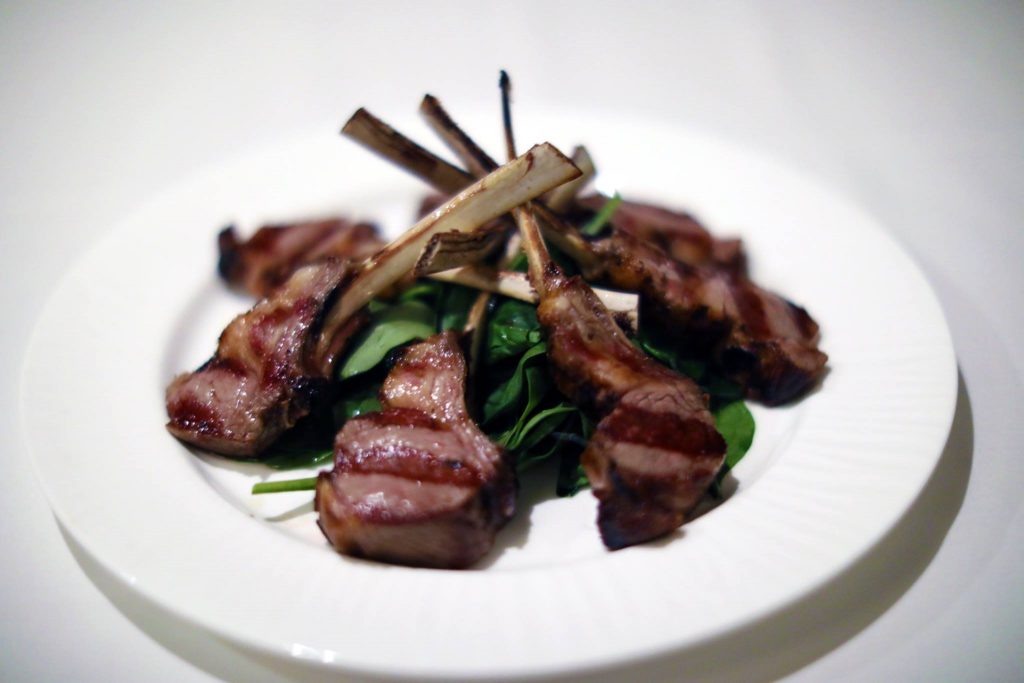 of potatoes, though I
think the mashed potatoes ($8)—starchy on a recent
visit—need work.
of potatoes, though I
think the mashed potatoes ($8)—starchy on a recent
visit—need work.
One of the
desserts that’s always been a crowd pleaser is the
zucchino
($10), a very rich layering of reduced English
cream, white chocolate and mocha mousse and
meringue.
I am
guessing that the reason that Flames Steakhouse is
such a bright, new example of its genre may be due
to Vulaj’s short retirement from the business, so
that, as so often happens with restaurateurs, he
couldn’t stay away and has re-entered it with a
whole new spirit and buoyant attitude to make it
better than ever.
Flames is open for lunch and dinner
Tues.-Sun.
❖❖❖
By Geoff Kalish
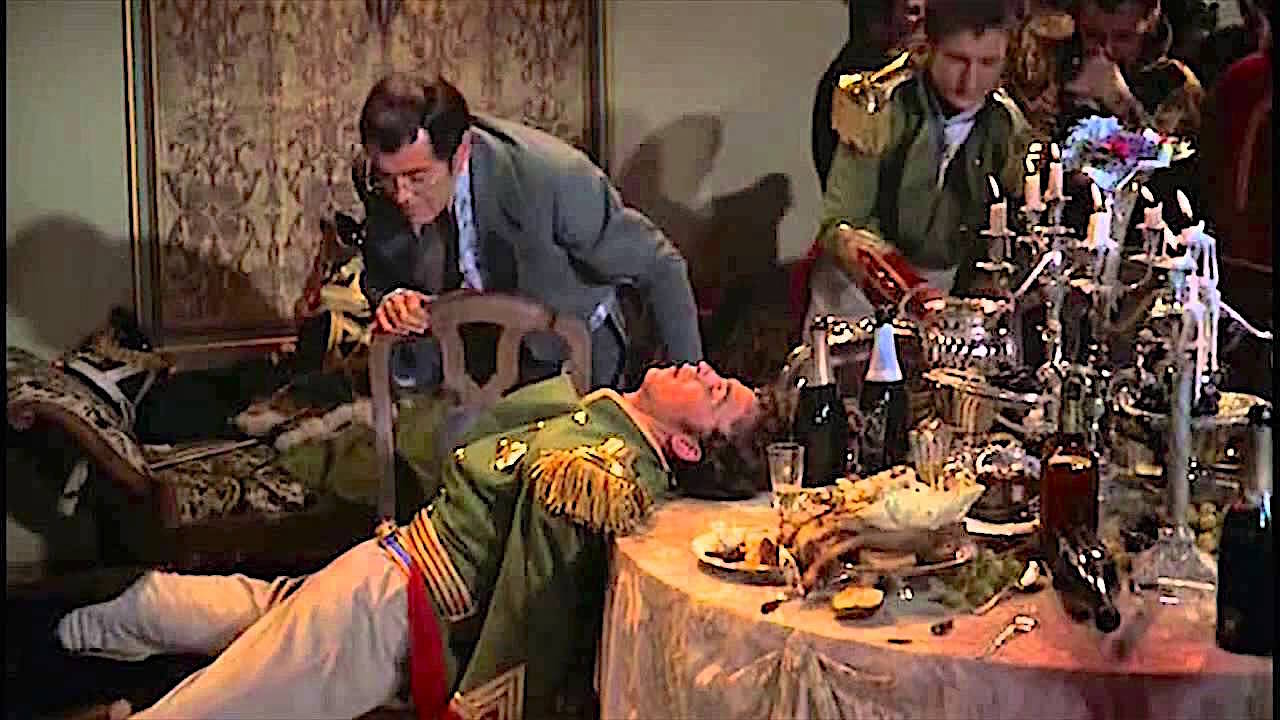
With the largest quantity of Champagne continuing to be sold between mid-November and the end of the year (at least in the U.S.), there’s been a major effort among a number of Champagne producers to make bubbly more than just a year-end holiday celebratory drink. In past years the marketing has focused on mixing classic Champagne with other ingredients, especially fruit juices (as in a mimosa) or Angostura bitters, with or without brandy (as in a Champagne cocktail).
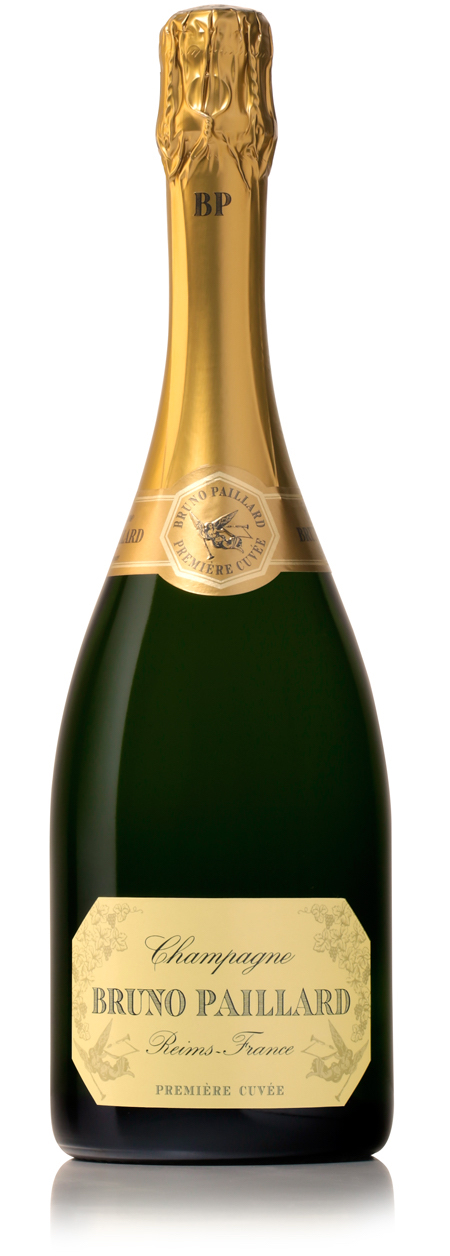 However,
since consumers rarely see what bubbly is added
to the mix, and since the sparkler is rarely the
main taste component, it’s not unusual for an
establishment to save cost by substituting a
sparkling wine other than Champagne to give the
drink its fizz. In fact, mimosas made with
inexpensive Prosecco or Spanish cava are the
norm for many spots. Attempts to promote
Champagne, especially rosés for Valentine’s Day,
have met with a similar fate, in that in many,
many instances a less expensive sparkler is
served, particularly as a “glass” of sparkling
rosé before or at the end of the traditional
romantic dinner.
However,
since consumers rarely see what bubbly is added
to the mix, and since the sparkler is rarely the
main taste component, it’s not unusual for an
establishment to save cost by substituting a
sparkling wine other than Champagne to give the
drink its fizz. In fact, mimosas made with
inexpensive Prosecco or Spanish cava are the
norm for many spots. Attempts to promote
Champagne, especially rosés for Valentine’s Day,
have met with a similar fate, in that in many,
many instances a less expensive sparkler is
served, particularly as a “glass” of sparkling
rosé before or at the end of the traditional
romantic dinner.
On the other hand, with his Champagnes now offered at more than 500 Michelin-starred restaurants, worldwide, it appears that Bruno Paillard, whom I met with on his recent visit to New York, has succeeded in his goal to produce food-focused bubbly and appeal primarily to those appreciating his sparklers with a meal. In fact, 80% of his annual output of 400,000 to 500,000 bottles is sold to restaurants, rather than to individual consumers through wine shops.
Accounting for
the elegant, food-friendly style of his
Champagnes—like the lush, fruity Brut Prémiere
Cru ($46), the zesty 2004 Vintage Assémblage
($90) and the newly released rich, “toasty” 2002
Nec Plus Ultra Brut ($180)—is an extreme
attention to detail and quality, with organic
farming of grapes, use of only “first-press”
juice and aging the wine on its lees for at
least 36 months, with only grapes from Grand Cru
vineyards, and more than ten years on its lees
for the Nec Ultra Plus. And, it seems, at least
based on visits to two top-tier Champagne
producers
in Reims—Taittinger and Veuve Clicquot—there’s a new focus on expanding the market by promoting “sweeter” styles.
As most savvy consumers know, the process of making Champagne was “invented” in the late 17th century by French physician Christopher Merret (right)—no, not Dom Pérignon—by adding sugar and yeast to still wine, causing a secondary fermentation with trapped carbon dioxide bubbles. Initially this was a dry wine, but it veered towards the sweet side to satisfy the taste of royalty in the 19th century, especially the czars of Russia. In fact, to make these sweet Champagnes even sweeter, consumers added sugar to them. However, over the years and with a change in consumer tastes, drier styles have been in vogue, especially in America. But, in an attempt to expand the market, at least some Champagne houses are producing at least a portion of their portfolios with more than a bit of sweetness. So, as Yogi Berra might have said, “there’s nothing so old that it’s not new again.”
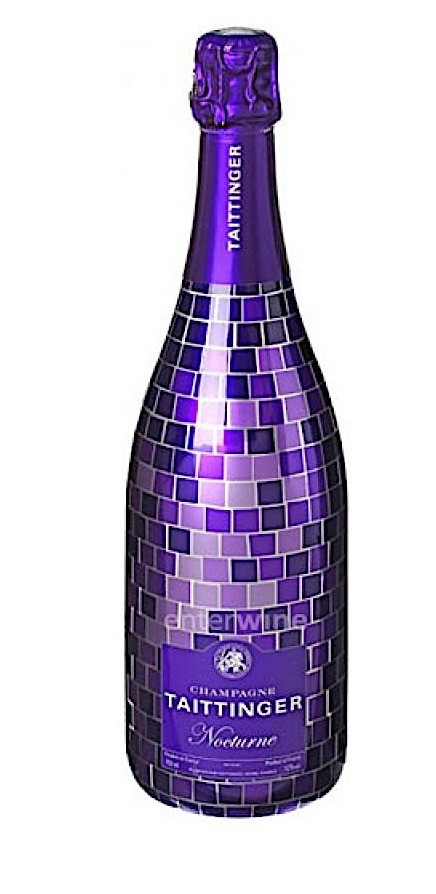 So,
while Taittinger
(left)
makes a number of excellent brut products,
particularly the vintage Comtes de Champagne
Blanc de Blancs ($170) and the non-vintage Brut
Préstige Rosé ($60), they have recently been
producing two “sweeter” sparklers: a non-vintage
Nocturne Blanc Sec ($58) and a non-vintage
Nocturne Rosé Sec ($60). Both sport festive
designer labels and are geared towards those who
find Champagne too “yeasty” or tart for their
taste. While I generally prefer the drier style
of sparkler, I actually found these two bubblies
more than mildly enjoyable. In fact, in addition
to being perfect accompaniments to a range of
hors d’oeuvres, including caviar, smoked salmon
and spanakopita, they made an excellent match
for spicy Asian fare, with the blanc showing a
bouquet and taste of brioche with hints of
blackberry, and the rosé featuring a bouquet and
taste of ripe strawberries.
So,
while Taittinger
(left)
makes a number of excellent brut products,
particularly the vintage Comtes de Champagne
Blanc de Blancs ($170) and the non-vintage Brut
Préstige Rosé ($60), they have recently been
producing two “sweeter” sparklers: a non-vintage
Nocturne Blanc Sec ($58) and a non-vintage
Nocturne Rosé Sec ($60). Both sport festive
designer labels and are geared towards those who
find Champagne too “yeasty” or tart for their
taste. While I generally prefer the drier style
of sparkler, I actually found these two bubblies
more than mildly enjoyable. In fact, in addition
to being perfect accompaniments to a range of
hors d’oeuvres, including caviar, smoked salmon
and spanakopita, they made an excellent match
for spicy Asian fare, with the blanc showing a
bouquet and taste of brioche with hints of
blackberry, and the rosé featuring a bouquet and
taste of ripe strawberries.
And, in a
concerted effort to cash in on the current
cocktail craze—yes, they’re back in style, or
depending where you’re from, they may not ever
have gone out of vogue—Veuve Clicquot with its
distinctive yellow label, is touting two new
products: Veuve Clicquot Blanc Rich ($65) and
Veuve Clicquot Rosé Rich ($65), both with more
than a touch of sweetness, primarily intended
for use in cocktail recipes. In fact, while
these bubblies provide enjoyment in their own
right (the blanc, with or after sweet desserts
or blue-veined cheeses, and the rosé with smoked
fish or spicy Thai fare), adding a slice of lime
or ginger gives them just enough flavor and zest
while cutting the sweetness a bit to make
excellent refreshing quaffing. In addition, when
served with a slice of cucumber they make
top-notch palate cleansers between courses of a
meal. And, I’m sure that inventive mixologists
will find additional ingredients to add to these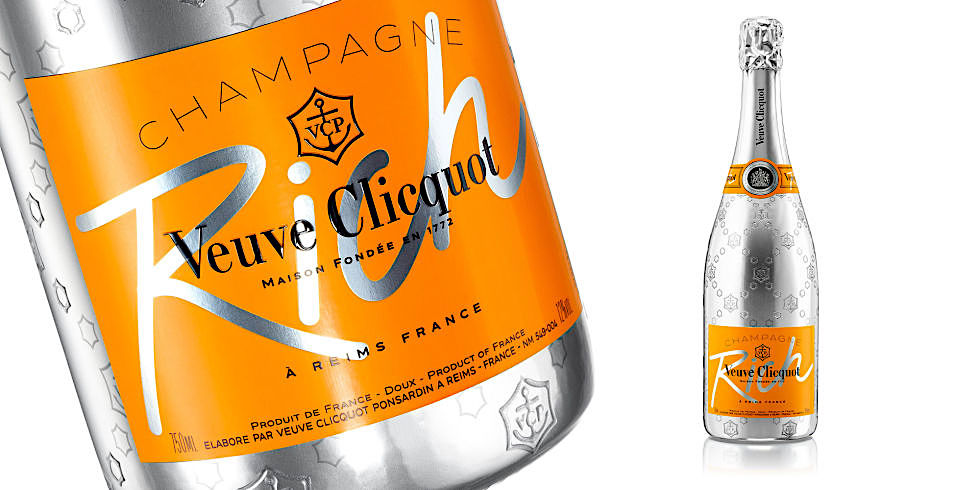
to bring further favor.
So, to enjoy for more than just a toast to a year-end holiday, expect to see sweeter wines like Taittinger’s Nocturne series and bottles of Veuve Clicquot Rich. They may not be for everyone, but in markets where they have made an appearance they seem to be high-flying hits. And while less costly “imitators” may make their market appearance, it is doubtful they will provide the quality of the Taittinger and Veuve Clicquot Champagnes. And, should these sweeter styles not be to your liking, there’s always the “dry” food-friendly bubblies from Bruno
Paillard, which, while costly, are well worth the price in terms of quality.
❖❖❖
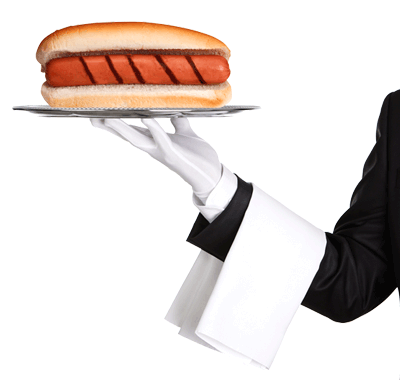 EXTRA! EXTRA! LOUISVILLE NEWSPAPER ADMITS
REPEATED INSTANCES OF FAKE NEWS!
EXTRA! EXTRA! LOUISVILLE NEWSPAPER ADMITS
REPEATED INSTANCES OF FAKE NEWS!
"On the following dates, the Louisville Courier-Journal incorrectly referred to hot dogs as
sandwiches: Oct. 2, 1887; Aug. 10, 1901; March
20, 1904; July 21, 1935; Jan. 14, 1939; May 4, 1941;
Sept. 15, 1950; June 29, 1958; Nov. 16, 1961; and Aug.
4, 1966. Among those errors were references to a
frankfurter sausage sandwich, frankfurter sandwich,
coney island sandwich, frankfurter sandwich with
mustard, and, the most egregious, a frankfurter sandwich
with catchup. We deeply regret the errors, especially
that last one."
WE HAVE A COUPLE OF SPECIALS I'D LIKE TO TELL YOU ABOUT THAT THE CHEF HAS PREPARED TONIGHT. FIRST THERE'S PRAIRIE DOG CHEEKS IN A REDUCTION OF CACTUS NEEDLES, AND THE THERE'S CORN SOUP WITH SHREDDED PRAIRIE DOG ENTRAILS, AND THEN A LOIN OF PRAIRIE DOG--TWO TO A PLATE--SMOKED OVER PEYOTE AND SERVED WITH PINTO BEANS. THERE'S AN ADDITIONAL CHARGE OF TEN DOLLARS IF YOU WANT THE DISHES PAIRED WITH WATER.

The Sioux Chef, the indigenous food
education and catering team, led by chef Sean Sherman,
is teaming up with the Minneapolis Park and Recreation
Board and the Minneapolis Parks Foundation to open a
Native American restaurant at a new riverfront pavilion
called Water Works. Wood-fired cooking will feature
prominently. “We’ve cut out things that weren’t
here before [Europeans came to America],” Sherman
explains. “So we’re not using any dairy, wheat flour,
processed sugar, beef, pork, or chicken, and are just
really being creative with proteins and plants and
agriculture that was here before.”
Any of John Mariani's books below may be ordered from amazon.com.
 The
Hound in Heaven (21st Century Lion Books)
is a novella, and for anyone who loves dogs,
Christmas, romance, inspiration, even the supernatural, I
hope you'll find this to be a treasured favorite.
The story concerns how, after a New England teacher,
his wife and their two daughters adopt a stray puppy found
in their barn in northern Maine, their lives seem full of
promise. But when tragedy strikes, their wonderful dog
Lazarus and the spirit of Christmas are the only things
that may bring his master back from the edge of
despair.
The
Hound in Heaven (21st Century Lion Books)
is a novella, and for anyone who loves dogs,
Christmas, romance, inspiration, even the supernatural, I
hope you'll find this to be a treasured favorite.
The story concerns how, after a New England teacher,
his wife and their two daughters adopt a stray puppy found
in their barn in northern Maine, their lives seem full of
promise. But when tragedy strikes, their wonderful dog
Lazarus and the spirit of Christmas are the only things
that may bring his master back from the edge of
despair. WATCH THE VIDEO!
“What a huge surprise turn this story took! I was completely stunned! I truly enjoyed this book and its message.” – Actress Ali MacGraw
“He had me at Page One. The amount of heart, human insight, soul searching, and deft literary strength that John Mariani pours into this airtight novella is vertigo-inducing. Perhaps ‘wow’ would be the best comment.” – James Dalessandro, author of Bohemian Heart and 1906.
“John Mariani’s Hound in Heaven starts with a well-painted portrayal of an American family, along with the requisite dog. A surprise event flips the action of the novel and captures us for a voyage leading to a hopeful and heart-warming message. A page turning, one sitting read, it’s the perfect antidote for the winter and promotion of holiday celebration.” – Ann Pearlman, author of The Christmas Cookie Club and A Gift for my Sister.
“John Mariani’s concise, achingly beautiful novella pulls a literary rabbit out of a hat – a mash-up of the cosmic and the intimate, the tragic and the heart-warming – a Christmas tale for all ages, and all faiths. Read it to your children, read it to yourself… but read it. Early and often. Highly recommended.” – Jay Bonansinga, New York Times bestselling author of Pinkerton’s War, The Sinking of The Eastland, and The Walking Dead: The Road To Woodbury.
“Amazing things happen when you open your heart to an animal. The Hound in Heaven delivers a powerful story of healing that is forged in the spiritual relationship between a man and his best friend. The book brings a message of hope that can enrich our images of family, love, and loss.” – Dr. Barbara Royal, author of The Royal Treatment.
 |
The Encyclopedia of American Food and Drink by John F. Mariani (Bloomsbury USA, $35) Modesty forbids me to praise my own new book, but let me proudly say that it is an extensive revision of the 4th edition that appeared more than a decade ago, before locavores, molecular cuisine, modernist cuisine, the Food Network and so much more, now included. Word origins have been completely updated, as have per capita consumption and production stats. Most important, for the first time since publication in the 1980s, the book includes more than 100 biographies of Americans who have changed the way we cook, eat and drink -- from Fannie Farmer and Julia Child to Robert Mondavi and Thomas Keller. "This book is amazing! It has entries for everything from `abalone' to `zwieback,' plus more than 500 recipes for classic American dishes and drinks."--Devra First, The Boston Globe. "Much needed in any kitchen library."--Bon Appetit. |
"Eating Italian will never be the same after reading John Mariani's entertaining and savory gastronomical history of the cuisine of Italy and how it won over appetites worldwide. . . . This book is such a tasteful narrative that it will literally make you hungry for Italian food and arouse your appetite for gastronomical history."--Don Oldenburg, USA Today. "Italian
restaurants--some good, some glitzy--far
outnumber their French rivals. Many of
these establishments are zestfully described
in How Italian Food Conquered the World, an
entertaining and fact-filled chronicle by
food-and-wine correspondent John F.
Mariani."--Aram Bakshian Jr., Wall Street
Journal.
"Equal parts
history, sociology, gastronomy, and just
plain fun, How Italian Food Conquered the
World tells the captivating and delicious
story of the (let's face it) everybody's
favorite cuisine with clarity, verve and
more than one surprise."--Colman Andrews,
editorial director of The Daily
Meal.com. "A fantastic and fascinating
read, covering everything from the influence
of Venice's spice trade to the impact of
Italian immigrants in America and the
evolution of alta cucina. This book will
serve as a terrific resource to anyone
interested in the real story of Italian
food."--Mary Ann Esposito, host of PBS-TV's
Ciao
Italia. "John Mariani has written the
definitive history of how Italians won their
way into our hearts, minds, and
stomachs. It's a story of pleasure over
pomp and taste over technique."--Danny Meyer,
owner of NYC restaurants Union Square
Cafe, The Modern, and Maialino.
|
 |
 |
 |
 |
 |
 |
 |
 |
 Everett Potter's Travel Report:
Everett Potter's Travel Report: 
 Eating Las Vegas
JOHN CURTAS has been covering the Las Vegas
food and restaurant scene since 1995. He is
the co-author of EATING LAS VEGAS – The 50
Essential Restaurants (as well as
the author of the Eating Las Vegas web site: www.eatinglasvegas.
He can also be seen every Friday morning as
the “resident foodie” for Wake Up With the
Wagners on KSNV TV (NBC) Channel 3 in
Las Vegas.
Eating Las Vegas
JOHN CURTAS has been covering the Las Vegas
food and restaurant scene since 1995. He is
the co-author of EATING LAS VEGAS – The 50
Essential Restaurants (as well as
the author of the Eating Las Vegas web site: www.eatinglasvegas.
He can also be seen every Friday morning as
the “resident foodie” for Wake Up With the
Wagners on KSNV TV (NBC) Channel 3 in
Las Vegas.

MARIANI'S VIRTUAL GOURMET
NEWSLETTER is published weekly. Editor/Publisher: John
Mariani.
Editor: Walter Bagley. Contributing Writers: Christopher Mariani,
Robert Mariani, Misha Mariani, John A. Curtas, Geoff Kalish, Mort
Hochstein, and
Brian Freedman. Contributing Photographer: Galina
Dargery. Technical Advisor: Gerry McLoughlin.
To un-subscribe from this newsletter,click here.
© copyright John Mariani 2017

